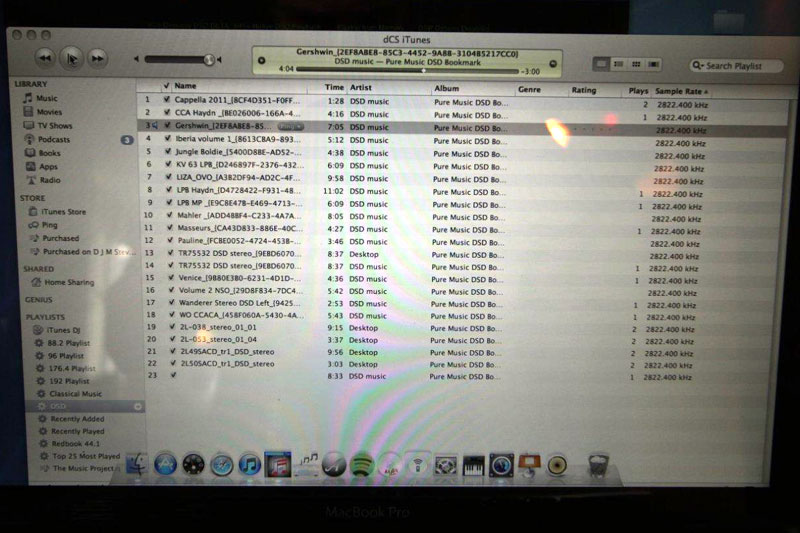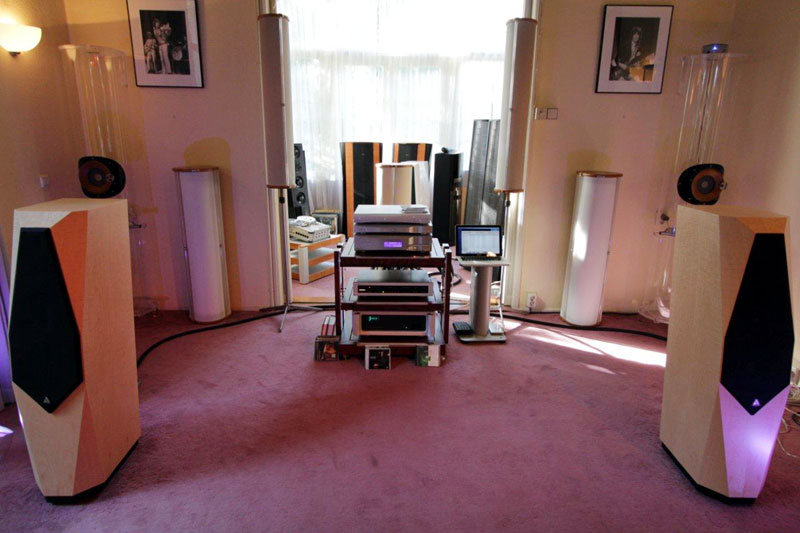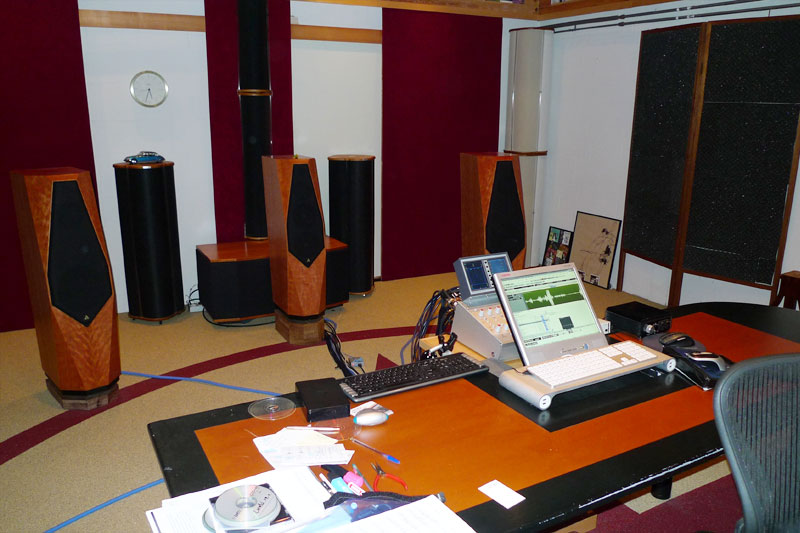DSD Over USB: An Open Standard
The day would be hosted in two locations. Initially, we were taken to Rhapsody Sound & Vision in Hilversum. This is a retail store, but it would probably be unrecognizable as such to most audiophiles. Harry van Dalen’s place is a large converted house bursting with fantastic hardware, lots of really interesting music and a very warm and informal atmosphere. Good things happen here. Initially Martin Odijik, the CEO of More Music, which imports dCS and other goodies into the Benelux countries, welcomed us. Martin kept the atmosphere light, which was good, because what was to follow was an in-depth presentation by Andy McHarg of dCS.
There are no standards for the streaming of DSD-encoded information, and this has not been possible over any USB interface. What dCS have come up with is an open standard of packaging pure DSD data. This will allow any DAC, providing it is capable of decoding 24-bit/176.4kHz data, to accept it. Andy was at pains to point out that there is no conversion to PCM and that the datastream is pure DSD. The method dCS have come up with seems quite ingenious, at least to the non-scientific mind. Andy went on to explain that DSD has a sample rate 64 times that of CD, but each sample is some 16 times smaller. This gives a data rate that is four times that of CD. Incorporating a PCM sample rate of 176.4kHz with each 24-bit sample translates to 16 bits for the raw DSD and the remaining 8 bits for the DAC to work out that it is being fed DSD and not PCM. Were dCS performing some magic trick with the datastream in order to keep all the data in the DSD domain? It seemed like it. But why go to such lengths? Was there a musical payoff? Enter Bert van der Wolf, joint founder and chief alchemist of Turtle Records, who let us hear the benefits of this dastardly digital trickery. Bert’s setup was sourced by a MacBook Pro running Channel D’s Pure Music. This was connected to a dCS Debussy DAC and U-clock, which fed Spectral amplification and a pair of Avalon speakers. Cabling was of the Spectral-approved MIT variety.
Bert is what I would describe as a laid-back kind of guy, although fiercely committed to sound quality and his way of recording music. He loves dynamic range and the expressive qualities that he hears in DSD and was about to prove it in no uncertain terms. He briefly prefaced each piece he played, letting the recordings do the talking for him. We started with a solo-piano recording, never one of the easiest instruments to convey through the medium of a hi-fi system. The balance of the actual physicality involved with the playing -- the hammers striking the strings and the sheer scale of the results -- remains an elusive thing to capture. How many mics should you use and where do you place them? How do you mix the ambient alongside the resonating frame of the instrument to present a realistic perspective? These are questions to which Bert had answers, as his recording provided superb insight into the musicianship, the piece and the instrument. I just couldn’t ignore what I was hearing in dynamic terms, and the scaling was superb. The power of the piano was tremendous, but the instrument wasn’t too big or overblown. The delicacy of the fingers on the keys was completely proportionate. Piece after piece followed. These were mainly classical and all had equal effect. This was dynamic range like I've never heard from CD, but the sound was tonally acute as well, and I never got the impression that the medium itself was inhibiting what Bert was trying to convey with his recordings. Finally he announced that a small jazz combo recorded live in a night club was coming next. This will be interesting, I thought. It all started with some snare work from the drummer. This was a textural, skinned snare, and I could sense the tension, not only of the skin itself but also in the club -- and in the listening room. Bang! The drummer’s foot hit that pedal and the feeling was like a sonic boom hitting us all in the chest. Only it never got a chance to rattle our bones -- the amplifiers tripped. Bert had asked a bit much from them and they needed to be powered off and on and the level attenuated somewhat so the system could deal with the frightening transients. After the listening session broke up we all had a bit of a mingle before hurtling down a Dutch motorway some 100km to get the rare and probably unique opportunity to hear Bert’s custom surround-sound setup in his mixing suite. David Steven of dCS had spoken to me briefly about the experience, and in a certain hushed tone that tickled my anticipation. I have heard surround-sound systems before and been left cold by their trickery-over-quality weirdness. This would, however, be very, very different.
Bert explained that his was "a selfish system," one he had set up for himself and was really best appreciated from a certain spot with the lights turned off. Only three of us at a time were allowed in the studio, and we all took turns in the sweet spot. What I heard was completely unlike any playback system I had experienced before. The sound was completely immersive, and you couldn’t do anything but give yourself up to it. The sense of being literally at the center of the experience was quite incredible. That solo piano I had heard earlier was astonishing. The sound was huge, yes, but the sense of scale that was so impressive earlier remained. The power and majesty of that instrument will live with me for a long time, as will the sheer articulation of the fingers on the keyboard. I actually couldn’t stop smiling. This was dynamic range and transient freedom like I have never heard -- nor expected. I could understand why Bert was so enamoured with DSD. The jazz-club piece, through bigger amps and speakers, was scary. It was as if the dynamic brakes were off and the anticipation of what was coming next had shot off the scale. Thank God Bert left the lights on. I was expecting a very loud and powerful acoustic trick from this multichannel system, but I ended up with a remarkable listening experience -- and a whole lot of questions. Could one re-create that sort of experience at home? Well, I guess in certain circumstances and with a big budget it could be approached, but Bert is a truly great producer of the type that I haven’t met for many years, and he has built this amazing installation purely for his own enjoyment. I admire that. I can understand now why dCS were so keen on the idea of
streaming DSD, as there are certainly very real musical benefits to be had. |



